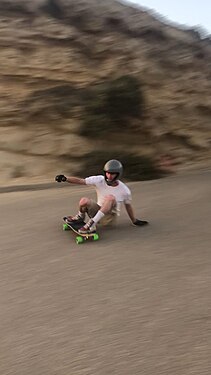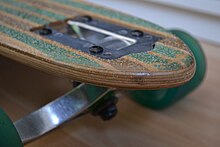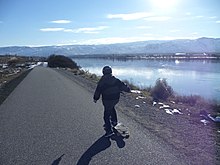Boardsports are active outdoor sports that are played with any sort of board as the primary equipment. These sports take place on a variety of terrains, from paved flat-ground and snow-covered hills to water and air. Most boardsports are considered action sports or extreme sports, and thus often appeal to youth. Some board sports were marginalized in the past. However, many board sports are gaining mainstream recognition, and with this recognition, they have gotten wider broadcasting, sponsorship and inclusion in institutional sporting events, including the Olympic Games.

A longboard is a type of skateboard typified by longer decks and wheelbases, larger-diameter and softer (lower-durometer) wheels, and often lower riding height compared to street skateboards, though there is wide variation in the geometry and construction of longboards. Among the earliest types of skateboards, longboards were inspired by surfing, with early longboards drawing from the design of surfboards, resembling and mimicking the motion of riding a surfboard, but adapted to riding on streets in a practice known as sidewalk surfing.

Mountainboarding (MTB), also known as dirtboarding, off-road boarding, and All-Terrain Boarding (ATB), is a well-established, but little-known action sport derived from snowboarding. The sport was initially pioneered by James Stanley during a visit to the Matterhorn in the 1990s, where snow was not available. A mountainboard is made up of components including a deck, bindings, four wheels with pneumatic tires, and two steering mechanisms known as trucks. Mountainboarders, also known as riders, ride specifically designed boardercross tracks, slopestyle parks, grass hills, woodlands, gravel tracks, streets, skateparks, ski resorts, BMX courses, and mountain bike trails. It is this ability to ride such a variety of terrain that makes mountainboarding unique from other board sports.

Street luge is an extreme gravity-powered activity that involves riding a street luge board down a paved road or course. Street luge is also known as land luge or road luge. Like skateboarding, street luge is often done for sport and for recreation.

Dirtsurfing is the sport of riding a Dirtsurfer brand inline board. This new Australian boardsport is correctly known as inline boarding because Dirtsurfer is a trademark protected brand name.
A freestyle skateboarding trick is a trick performed with a skateboard while freestyle skateboarding. Some of these tricks are done in a stationary position, unlike many other skateboarding tricks. The keys to a good freestyle contest run are variety, difficulty, fluidity, and creativity. This is an incomplete list, which includes most notable tricks.

A slide is a skateboarding trick where the skateboarder slides sideways either on the deck or the trucks.
Pumping is a skateboarding technique used to accelerate without the rider's feet leaving the board. Pumping can be done by turning or on a transition, like a ramp or quarter pipe. When applied to longboards, it is also known as Long distance skateboard pumping or LDP. Pumping is a technique similar to pumping a surfboard.

A caster board, vigorboard or waveboard is a two-wheeled, human-powered land vehicle. Other names are J-board and RipStik, both of which are derived from commercial brands.
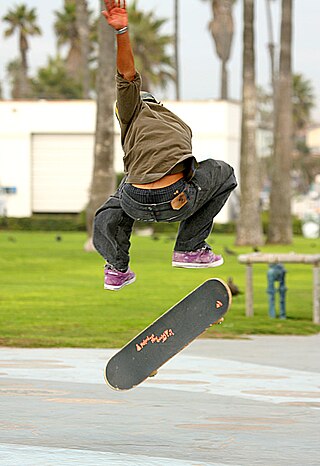
A skateboard is a type of sports equipment used for skateboarding. It is usually made of a specially designed 7–8-ply maple plywood deck and has polyurethane wheels attached to the underside by a pair of skateboarding trucks.
A skateboard style refers to the way a skateboarder can ride a skateboard. Styles of skateboarding have evolved and are influenced by a number of factors including sociocultural evolution, mass media, music, technology, and corporate influence.

Slalom skateboarding is a form of downhill skateboard racing that first appeared in the 1960s and 1970s and has made a resurgence in popularity in the 2000s. Slalom racers skate down a course usually marked by plastic cones. The racer tries to get through the course with the fastest time, while knocking down the fewest cones. Each cone typically carries a penalty of a fraction of a second which is added to the skater's time.
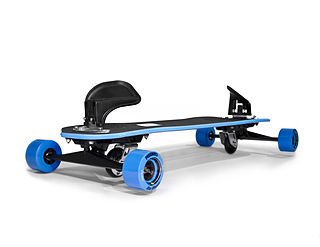
A freeboard is a specialist skateboard designed to closely simulate the behavior of a snowboard. Freeboards were developed to allow snowboarders to transition to skateboarding without the need to adapt to a smaller deck and narrower wheel-base.

A brakeboard is a skateboard fitted with a specialised truck assembly that includes a braking mechanism.

An electric skateboard is a personal transporter based on a skateboard. The speed is usually controlled by a wireless hand-held throttle remote, or rider body weight-shifting between front of the board for forward motion and rear for braking. As for the direction of travel to the right or left, it is adjusted by tilting the board to one side or the other. The classification of electric skateboards and legality of their use on roads or pavements varies between countries.

Street skateboarding is a skateboarding discipline which focuses on flat-ground tricks, grinds, slides and aerials within urban environments, and public spaces. Street skateboarders meet, skate, and hang out in and around urban areas referred to as "spots," which are commonly streets, plazas or industrial areas. To add variety and complexity to street skateboarding, obstacles such as handrails, stairs, walls, flower beds, bins, park benches, picnic tables, and other street furniture may be traversed as single tricks or as part of a series of consecutive tricks called a "line."
Freeride is a discipline of the sport longboarding. Freeride is the compound word referring to the act of descending a riding surface interspersed with various maneuvers such as semi-perpendicular slides by breaking traction and carving. There are techniques that slow, or "check" speed, quickly assuming the previous riding stance & continuing forward progress. This sliding makes important use of one of the minimal safety devices used ;slide gloves. These uhmw polyurethane or Delrin© puck equipped gloves permit the freeriders the ability to place a palm down on the ground during the apex of slides to act as a form of outrigger of-sorts, supporting the rider's weight as they slide to shave speed-off their rapidly accelerating decent of a hill. Eventually, as rider experience increases, the need to assist ones balance through the use of "hands-down" style decreases & more experienced freeride practitioners can perform the same results via "standup slide" "pre-checks". Standup slides take much practice and experience to accomplish. The sliding style itself can have very different & custom- tailored characteristics, this being based -on many factors such as riding style, board geometry, truck setup, bushing durometer, hill angle and distance, the asphalt or concrete road surface quality and most importantly, the particularly wheel size,shape and material choice ridden.
A Penny board is a type of skateboard that is characterized by a short and narrow plastic deck. Although such skateboards were first manufactured during the 1970s, their name and contemporary popularity come from the Australian brand Penny Skateboards, founded in 2010. The company's name has since been widely genericized to describe all small plastic skateboards.
Surfskating, or surf skateboarding, is a form of skateboarding that replicates the experience of surfing on dry land. A surfskate system is distinguished from a traditional skateboard system by the utilization of two different trucks, front and back, with specific functions and geometries that, together, yield thrust, just like a surfboard.
